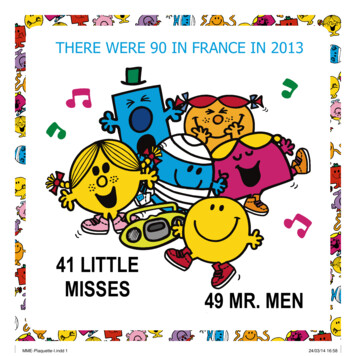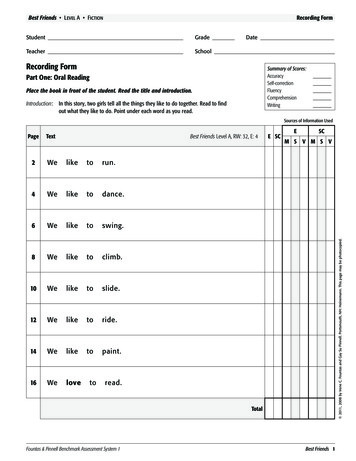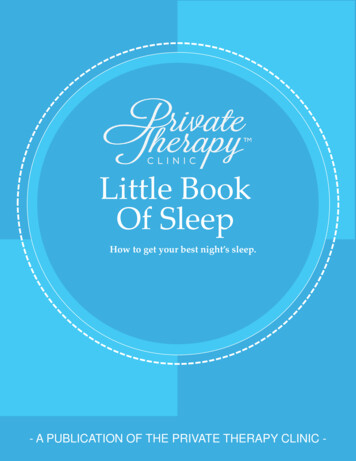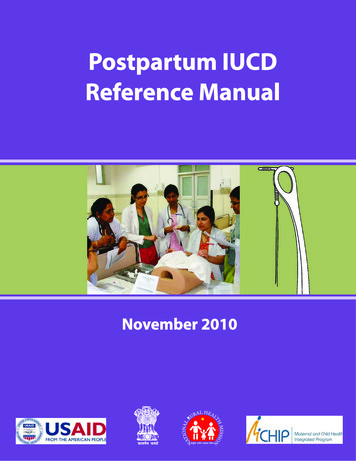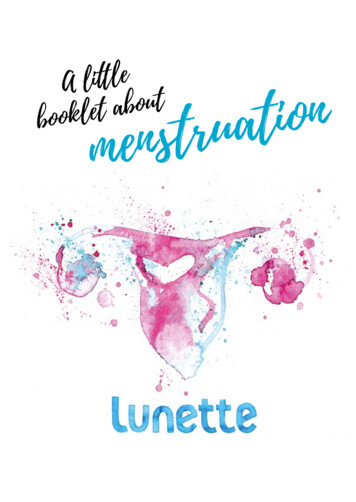
Transcription
A littleoutbatelkobonoitaurtsnem
ForewordThe m-word: menstruation. What is this mysterious process thathappens monthly, how will it affect me, and why does it matter?In this pocket-sized booklet, you will find a wealth of information,answers to these questions and more.Team lunette has written this booklet primarily for YOU:young girls becoming women, ready to begin an exciting newphase of life. We also want our little book to be ’parent-friendly’and welcome feedback. We hope to encourage easy and opendiscussions about this new, exciting, and sometimes confusingpart of a young girl's life.It’s important to keep in mind that notevery woman menstruates and not everyperson that menstruates is a woman.There are misconceptions attached togenders and sexualities that are so oftentied to our bodies. Although we talkabout girls and women we hope thatyou will find this booklet helpfuleven if you don't identify as awoman. What are we waitingfor? Let’s get started.2
ContentForeword. 2Puberty.4Anatomy.6External anatomy.7Internal anatomy.9Menstruation .14Menstrual cycle . 16Menstrual calendar.center spreadHistory of feminine hygiene . 18Different menstrual products . 22Differences between products .25Choosing the menstrual cup .26Use of the menstrual cup .28FAQ.303
PubertyPuberty begins with girls on average between ages 8 and 13,usually one to two years earlier than boys. Is it any wonder that inalmost any classroom across the world boys are being boys, andgirls are rolling their eyes in exasperation?WHAT WILL HAPPEN TO MY BODY DURINGPUBERTY?The signs of puberty are: growth spurts, hips become wider, breastsbegin to develop, and hair begins to grow on legs, underarms andgenital area. What comes next? Every girl is different and the signsof puberty also vary, so there is no point in comparing yourself toyour classmates. Everyone develops at their own rate.WHAT TO EXPECT?As breasts begin to develop they may feel tender or sore and onebreast may grow quicker than the other. This is completely normaland nothing to worry about. Some girls may develop acne and oilyskin.Discharge from the vagina is a sign that the body will soonbe ready for menstruation to begin. It plays an important rolein maintaining and cleaning the vagina. Later the color andappearance will vary depending on the phase of the menstrualcycle. (See section menstrual Cycle on page 16)4
PERSONAL HYGIENEMany girls sweat more during puberty and it’s normal that the skinand the hair will get greasy more frequently. Personal hygiene iskey here, starting with fresh underwear and a daily wash of thevulva with water. No need to clean the vulva with soap or intimatewashing lotion. Water is the best cleanser, but don't overdo it.It's not recommended to wash the vagina. Discharge cleans thevagina and washing, especially with cleaning agents can damagethe healthy environment of the vagina. Over washing often leadsto dryness and itching. Puberty lasts several years and during thattime a girl becomes a woman.Puberty is much more than just changes in the body — the mindchanges as well. Thinking and perceptions change as well as theups and downs of growing up. Mood swings are normal, and eventhough they aren’t easy to live through will soon pass. Adults aren’timmune to mood swings either.5
AnatomyTeam lunette believes that every woman should take the time toget to know herself and her body. A deeper understanding of howthe two are connected will lead to a more rewarding life. We seekto set aside superstition, myths and taboos about womanhoodand get to the heart of the matter — what it means to be a womanin every aspect.Get comfortable with getting to know your own anatomy. Every girland woman is unique and knowing your body (and what’s normalfor you) is the key to knowing yourselfand finding what works for you. Whatworks for you - choice of sanitaryprotection, coping mechanismsfor cramps and mood swings,and more - is part of knowingyourself.6
clitoral hoodclitoral headthe urethral openingthe labia majorathe labia minoravaginal openingthe damExternal anatomyAs the term implies, the external female anatomy includes thegenitals that are outside the body.THE MONS PUBISThe mons pubis, or mons veneris is the slight elevation above thefemale pubic bone which protects and cushions the bone duringsexual intercourse. After puberty, this area is covered with pubichair.THE LABIA MAJORAAlso called the outer lips, the labia majora are the outer folds ofskin surrounding the vaginal opening. They are usually larger thanthe labia minora, but it is not uncommon for the inner lips to be thesame size or larger than the outer lips. The labia majora can vary incolor—pink, crimson, reddish brown - all of which are considerednormal. They can also vary in length from short to long and mayappear smooth or wrinkled. The outer lips serve as a protectivelayer to shield the genitals from dirt and bacteria.7
THE LABIA MINORAThe labia minora, or inner lips, are the thin folds of skin withinthe labia majora. The inner lips cover the vaginal and urethralopenings. This area within the labia minora is called the vestibule.The inner lips of the labia are multi-purpose: they are another layerof protection to keep bacteria from entering these openings andthey contain nerve endings that enhance sexual pleasure.THE CLITORISLocated just above the urethral opening, the clitoris is a highlysensitive part of the genitals located at the top of the vulva. Theclitoral hood (prepuce) protects the visible tip of the clitoris. Theonly purpose of the clitoris is to create sexual pleasure.THE URETHRAL OPENING (URETHRA)The urethral opening is located just below the clitoris. The urethrais a tube connected to the bladder through which urine passesfrom the body.THE VAGINA / VAGINAL OPENINGThe opening to the vagina is located below the urethral opening.You can find out more about the vagina in the next sectiondiscussing internal anatomy.THE DAM (PERINEUM)The dam is the region between the anus and the vulva.THE ANUSThe anus is the opening through which the feces leaves theintestine. This area can also be covered with pubic hair.8
Internal anatomyThe internal female anatomy includes the parts you can’t see, butwhere all the reproductive action happens with the vagina, cervix,uterus, fallopian tubes and ovaries. Whether or not a baby is present,the hormonal functions of these organs impact a woman’s daily life.VAGINAThis is the muscular tube that connects the external genitals tothe cervix of the uterus. The vagina is approximately 2 to 4 incheslong and can double in length when a woman is aroused. The wallsof the vagina can be described as layers of wrinkles or folds ofmuscular tissue. Menstrual blood flows from the uterus through thefallopian tubeovaryuteruscervixvaginahymen9
belly buttonsmall intestinefallopian tubeovarycolonuterusbladderpubic bonecervix, and exits the body through the vagina. Mucus is generatedto keep the vagina moist, enable lubrication for sex, trap semenfor conception, and to cleanse the vagina after menstruation. Howmuch mucus the vagina creates during a cycle varies; it usuallyincreases about two weeks prior to menstruation. The discharge isa natural occurrence and helps maintain the health of the vaginaby removing bacteria that may have entered through the vaginalopening. The characteristics of discharge amount, color, eventexture also vary from woman to woman.HYMENLocated just inside the opening to the vagina, the hymen — alsoknown as the vaginal corona — is a thin membrane of tissue thatpartially covers the vaginal opening in many young girls. The absenceof a hymen is not a sign of lost virginity since it can be broken duringmany nonsexual activities, like sports. The hymen tends to erode overtime due to hormones, natural discharge, and vaginal sex.10
PUBIC BONEThe pubic bone is actually the joint where the two halves of thepelvis meet and is inside the vagina about 1 to 2 inches. Beingable to identify the curve of the pubic bone from within the vaginais important for the proper placement of a menstrual cup. Amenstrual cup needs to be positioned just beyond the pubic bonefor proper placement.CERVIXThe cervix is the narrow, neck-like passage that forms the lowerend of the uterus. If you search for it with your finger, it feels abit like the tip of your nose. Menstrual blood leaves the uterusthrough the cervix where it passes through the vagina. Sementravels through the cervix to enter the uterus. And in pregnantwomen, the cervix stretches or “dilates” to allow the baby to passthrough during vaginal delivery. The position of the cervix variesfor every woman and its position can change during the menstrualcycle as well as throughout a woman’s life.THE UTERUSThe uterus is a pear-shaped, muscular structure where a fetusdevelops during pregnancy. If an egg enters the uterus and is notfertilized by sperm, the inner lining of the uterus sheds and passesfrom the body during menstruation.THE FALLOPIAN TUBESThe fallopian tubes extend from either side of the uterus. It isthrough these tubes which an egg released during ovulation musttravel to the uterus. If an egg is not fertilized, it passes through thecervix and vagina as part of the menstrual period.11
OVARIESOvaries are positioned on either side of the uterus. They produceand store eggs. The ovaries are approximately the size of a grapeand have a lumpy appearance.PELVIC FLOORThe pelvic floor, or pelvic diaphragm, is located underneath thepelvis and can be described as a sling of muscles and connectivetissue spanning the pelvic opening. The pelvic floor providessupport for the uterus and vagina as well as other organs in thisarea of the body, including the bladder, intestines and rectum. Themuscles and tissue hold these organs in place and allow them tofunction correctly.12
The following exercises will strengthen your muscles and improveyour pelvic floor function:1. SQUATTINGStand with your feet shoulder wideapart. Gently contract your pelvic floorand abdominal muscles. Squat as ifyou were sitting on the top of the backof a chair. Then stand. Repeat. This willstrengthen your pelvic floor, glutes andthigh muscles.2. HIP RAISESLie on the floor, on your back, and gentlycontract your pelvic floor and lowerabdominal muscles. Using muscles inyour abdomen, lower back and thighs,lift your hips as high as you can. At thehighest point, tighten your pelvic floormuscles. Then slowly lower your hipsto the floor. Repeat.13
MenstruationMenstruation, also called your period, is a normal occurrence inthe life of a healthy woman. Having a period will not limit your life ifyou have a positive attitude towards your period. Nowadays, thereis a large choice of menstrual hygiene and sanitary protection,which will allow you to continue with your everyday activitiesduring your period. Some girls and women report suffering fromirritability before or during their periods. This is known as PMSor PMT premenstrual tension. If you suffer from very bad PMSor pain during or before your period speak to your doctor. Thereare treatments available. However, every woman's experienceof menstruation is different and some women don't get anyPMS symptoms at all. Menstruation begins within 1-3 years afterthe beginning of puberty, after the growth spurt and breastdevelopment.In Central Europe, girls experience their first period on averagearound 13 years, some as early as 8.Menstrual cramps can be relieved by proper diet and exercise. Ifplaying sports or going out for a walk is the last thing on your mindwhen you have cramps, remember that moving your muscles helpsstimulate the production of the happiness hormone, serotonin. Eatplenty of green vegetables, which are rich in magnesium and drinkplenty of water.Getting a good night’s sleep helps with the ’crankiness’associated with menstrual mood swings, as does watching yourcaffeine intake.14
For most women menstruation lasts in average a few days andfollows one of these patterns:lightheavymoderatelightvery lightheavyheavymoderatemoderatevery lightPeriods usually begin from the ages of 9 and even as late as 16.In the early 20th century, girls got their first period on average at17. If you have not gotten your period by age 16, it’s a good idea togo and see your doctor.Often the first signs of the early onset of menstruation is agrowth spurt and vaginal discharge. In rare occasions, some girlsexperience discharge years before the onset of their first period. Inthe first 1-3 years, periods may be irregular.Menstruation lasts on average 3-7 days. The total amount ofblood that is lost during an average period appears to be so muchmore than it actually is; it’s usually only about 4 teaspoons. But therange is between 1 and 4 tablespoons.The consistency of the blood is usually thick and bright redduring the heaviest days of the period though it is not unusual tosee clots during this time. At the beginning and end of the period,the colour of the blood may be brownish. This is normal.15
UterusOvaryFallopian tubeCervixVaginaUterusOvaryFallopian enstruationFSHLH14Estrogen1428Menstrual cycleThe menstrual cycle begins on the first day of your period and endson the first day of the next period. The cycle lasts for an average of28 days,though anywhere from 21 to 45 days is considered normal.Every woman has her own individual cycle. Few women have theirperiod regularly - it is normal that the cycle is a couple of daysshorter or longer. Lifestyle choices such as stress, smoking andnutrition control the regularity of the menstrual cycle. Also, it isnormal for your periods to be irregular for the first couple of years.As an embryo, it is already clear how many eggs a woman canproduce during her life. At birth, a girl bears in her hundreds ofthousands of unripe eggs. From puberty on, they mature. One16
Menstrual calendarOn the following pages, you’ll find a menstrual calendar. With thisspecially designed calendar, you can calculate and follow your cycle.Three rows of icons are available for every month, and on the back,there’s a list of symbols that you can use.On the first line of the month, you mark the first day of your period:under the appropriate month and the corresponding day your periodstarts. On the first line, you can put comments on your period ordischarge. This information will help you assess what’s happening infuture periods and anticipate when your next period will begin.On the second line, you can also make comments on changes in yourbody, or in your life. Did you know that, for example, stress, or even aplane trip, etc. might cause your period to be late? On the third line,you can mark how you feel emotionally and physically. Many womenfeel sexually attractive during ovulation and irritated during the daysbefore menstruation. These characters can serve as a guide for excitingself-discovery. After a few months, you’ll notice that certain similaritiesbetween your cycles exist. Maybe you’ll have a severe headache on thefirst day of your period or even desire for chocolate before your period.It’s possible that you may be fearful in certain phases of the cycleor even have intense dreams. If you pay attention to the consistencyof the discharge, you can learn about your fertility: when ovulationhappens and when the next period begins. If you are using hormonalcontraceptives, such as the pill, when you get your period dependson the particular type of pill you're taking. Hormonal contraceptivemethods such as the pill, patch etc will affect the hormonal balance ofyour body, the vaginal discharge, and your mood.
Menstrual calendar1 23 4 5 6 7 8 9 10 11 12 131 23 4 5 6 7 8 9 10 11 12 131 23 4 5 6 7 8 9 10 11 12 131 23 4 5 6 7 8 9 10 11 12 131 23 4 5 6 7 8 9 10 11 12 131 23 4 5 6 7 8 9 10 11 12 13
14 15 16 17 18 19 20 21 22 23 24 25 26 27 28 29 30 3114 15 16 17 18 19 20 21 22 23 24 25 26 27 28 29 30 3114 15 16 17 18 19 20 21 22 23 24 25 26 27 28 29 30 3114 15 16 17 18 19 20 21 22 23 24 25 26 27 28 29 30 3114 15 16 17 18 19 20 21 22 23 24 25 26 27 28 29 30 3114 15 16 17 18 19 20 21 22 23 24 25 26 27 28 29 30 31
travelloss of appetiteback acheheavy bleedingstomach problems,creamyelasticwetheadachestickyAdd your ownie. diarrheapimpledry (no leukorrhea )LEUKORRHEAstressfood cravingmoderate bleedingZsore breastslight bleedingillnesssleepfull moonnew moonswellingspottingOTHERYOUR sexualemotionalmelancholicenergichappyMOOD
or sometimes several eggs are released during ovulation. In herfertile years, a woman has an average of 520 menstrual cycles.The menstrual cycle is governed by hormonal changesthroughout the body. The cycle can be split into two main phases:the (ovarian) follicular phase and the luteal (corpus luteum)phase. The follicular phase is the first phase of the menstrual cycle.The follicular phase will take 10 to 14 days. The endometrium, theinner lining of the uterus, thickens at this stage in preparation forovulation. Hormones stimulate the maturation of the follicle oregg (ovum).The luteal phase begins with the release of the ovum fromthe ovary into the fallopian tubes. The endometrial lining is nowprepared for the implantation of the fertilized ovum. If the ovumhas not been fertilized, the levels of estrogen and progesteronedecrease and the breakdown of the uterine lining begins. Theunfertilized ovum is about the size of a grain of sand; it is shed aspart of the menstrual fluid.The luteal phase lasts until the beginning of the next period. Inthe days following the period there is usually no discharge.As the hormones stimulate the growth of the follicle the cervixproduces a thick mucus plug to prevent bacteria and spermfrom entering into the uterus. This may be observed as a thick,white, sticky, odourless vaginal discharge. Vaginal discharge nearovulation is typically very stretchy, slippery, and clear (looks andfeels like egg whites). This fertile fluid helps the sperm movetoward the ovum and protects sperm from the acidity of thevagina, which would normally kill them. After ovulation, before theperiod, there is little to no vaginal discharge.The fluctuating levels of hormones during the menstrual cyclecause many physical changes. Your body temperature might riseand fall during the cycle. You’ll experience vaginal discharge,17
and sometimes abdominal cramping during ovulation or at theonset of menstruation. While some women have an increasedappetite before their period, some are irritated or depressed.These symptoms are known as PMS or ’Pre-menstrual syndrome.Menstrual headaches and stomach cramps are also a potentialside-effect. For many women, these symptoms are minimal, butfor some women these symptoms can be quite severe.The more you get to know your own body, the more you canlearn about your own unique cycle and better understand yourmonthly rhythm.History ofFeminine HygieneIt’s hard to believe that the history of feminine hygiene products isquite short although women have had periods since the beginningof time. Our great-grandmothers could not purchase sanitary padsin stores. Previously, women had to somehow cope with whatevermaterials they had at hand: cloth, moss, wood or natural sponges.Today there is a wide selection of products for feminine protection.There are all kinds of pads, tampons, panty liners and menstrualcups. But even today, there are still countries where girls and18
women for religious or cultural reasons are isolated fromthe community when they have their periods. Conversely,there are also cultures where the girl’s first menstruationis celebrated.Over the years there’s been significant development inthe materials used to create sanitary protection products.On the following pages, we present a few developments,which have, in our opinion, had a great impact on thewellbeing of women and on the attitudes towardsmenstruation.Egyptian women used soft Papyrus as a tampon. InGreece, women wrapped gauze strips around a pieceof wood and used it as a tampon. In Rome tampons andpads of wool were produced. In other parts of the worldalso paper, moss, wool, animal skins or grasses were usedas absorbent materials.Since the Middle Ages, the natural healer Hildegardvon Bingen (1098 - 1179 D) emphasized the great benefitsof the menstrual period. She championed the conceptthat the female body undergoes a natural detoxificationand cleansing.In rural Europe, it was normal to use no protection atall. Menstrual bleeding was considered toxic and wouldcause inflammation if you prevented the flow. Womenwore long shirts or layers of skirts to absorb some of themenstrual blood.Many women used homemade pads, often using thesame cotton material that was used in baby diapers. Thepads were fastened on underwear or on homemadegauze belts. In the USA women could mail order apronsmade out of latex. Their purpose, however, was to protect19
the clothing and not to absorb the menstrual blood. Forthe same purpose women used thick petticoats.Nurses in France recognized the absorbing capacityof the cellular bandages that were used for the woundedsoldiers. They used these bandages as menstrualproducts.The first mass-produced disposable pads came onthe market in the USA and were a great step forward. Butas they were 56 cm long and 9 cm wide they could notbe used without a reusable sanitary belt. There was also arevolution in fashion: the underwear became tighter andfitted and held sanitary pads and sanitary belts in place.Leona Chalmers patented and started to producethe first reusable menstrual cup made out of naturalrubber. The women, however, were not ready. Disposableproducts were considered a sign of higher standard ofliving and women were not willing to face their menstrualblood so directly.In 1931 Dr. Earle Haas filed a patent for the firsttampons with applicators. That was the ”tube in tube”system, which is still today in use. Gertrude Tendrichbought the patent for 32,000 and the company Tampaxwas founded in 1933. First she made tampons at homewith her sewing machine and Dr. Haas’s compressionmachine."The future of feminine hygiene" proclaimed the O.B.ad in the 1950s. The novel tampons without applicatorsquickly became very popular. In the first German televisionadvertisements for tampons women were whispering thesecret ”Tampax”. In 1959 Tassette brought the menstrualcup back on the market in the United States, this time20
with a large advertising budget. The demand, however,was not large and the Tassette disappeared.The first pads with adhesive backings came on themarket and finally put the era of belts and safety pins toan end.The first perfumed tampons and pads and thetampon Rely ("we'll even absorb the worry”) appeared onthe market. Proctor & Gamble took Rely tampons off themarket in 1980, when the new material used in them wasassociated with the deadly Toxic Shock Syndrome.The first pads with wings appeared on the market.Also, progress was made on the materials and the firstthin pads were launched towards the end of the decade.In a television campaign from the 1990s O.B. wanted todiscuss the taboo of menstruation. For the first time, theactual product was shown and the word ”menstruation”said out loud. ”Clean and discreet” it was to be. Even asrecently as in 2010 two major network channels in theUSA banned a menstrual product ad that had the word”vagina” mentioned in it.Silicone, a new well-tested material from the medicalfield was used for the first time to manufacture a menstrualcup. This ultra hygienic material made it possible forlatex allergy sufferers to use the menstrual cup. Throughthe Internet, many women from around the world wereexposed to new alternatives in menstrual protection.21
Different menstrualproductsToday there is a wide range of disposable and reusable menstrualproducts. There are products that are used internally and externallyas well as products that absorb blood and collect it.Disposable products are disposed of with normal householdwaste; compostable products can be put into the home compost.We believe that disposable items shouldn’t be flushed down thetoilet. Reusable products are cleaned after use. When they cometo the end of their life span, cloth pads can be disposed of throughnormal household waste. Menstrual cups made of silicone can beburned.Toxic Shock Syndrome (TSS) is a bacterial infection, which canenter the body through a wound or the mucous membranes.TSS symptoms include sudden high fever, sore throat, vomiting,diarrhea, dizziness, solar-dermatitis like rash, a low blood pressure,muscle pain, fainting or coma. TSS is very rare but can be fatal.Both women, men and children can be affected. The majority ofreported cases are young girls and women under 30, so TSS isconnected with the use of very absorbent tampons. Early diseasedetection and treatment is critical. If you have some of the abovementioned symptoms, remove the tampon or menstrual cupimmediately, contact your doctor and explain that you suspect aTSS infection.22
PADSIt’s a good idea to get used to your period with a pad, whichadheres to your underwear. Some pads are provided with wings sothey sit better and insure that there’s no leaking. The pad absorbsthe blood flow and it is changed according to need. At night youcan use larger and more absorbent pads.There are disposable pads, which are mostly made of celluloseand plastic. The reusable cloth pads are washed after use in thewashing machine at 140-194 degrees Fahrenheit. Then you canuse them again. The cloth pads are soft and since they do notcontain any plastic they are not sweaty like disposable pads canbe.PANTY LINERSThe panty liner’s function is very similar to a pad but they arethinner and narrower. They don’t absorb as much blood as the padas they are actually not meant for your period but for dischargeand spotting on lighter days. For light bleeding, they are also23
suitable if you feel that a normal pad would be too bulky.Since disposable panty liners include plastic, they may besweaty and cause problems with the PH balance of the vagina soit’s good sense to take breaks with their use or start using clothpanty liners.TAMPONSA tampon is worn inside the body, specifically near the cervix,and there it absorbs blood. Tampons are usually made of cottonor rayon. There are tampons with applicators and without. Thetampon is inserted with clean hands into the vagina, a stringremains outside the body. With this withdrawal string, you canremove the tampon. There are tampons with different absorptioncapacities. It is important to always choose the right size becauseif they are too absorbent, they will dry out the mucous membranes.Absorbent tampons are also associated with TSS, a rare but verydangerous disease.You should change the tampon every few hours. Tamponsshould not be used at night. You should not use tampons fordischarge.MENSTRUAL CUPThe menstrual cup is a reusable menstrual hygiene product that isworn internally. Most menstrual cups are made of medical gradesilicone. With proper care, you can use the menstrual cup for yearsand thus it is an economic and environmentally friendly alternativeto conventional menstrual products. According to studies, themenstrual cup does not change the natural environment of thevagina, nor does it dry you out. Many menstrual cup users havenoticed that they get less irritation and yeast infections comparedto when they used tampons or pads.24
The menstrual cup is inserted with clean hands into the lowerpart of the vagina where it collects the blood. If it is properly inplace, it won't leak and you won't be able to feel it. The menstrualcup is emptied 2-4 times a day and at every emptying rinsed. Themenstrual cup can be used even at night (up to 12 hours withoutemptying), and you can use it while swimming and sports. Themenstrual cup made of silicone can be disinfected by boiling orcleaned with rubbing alcohol.The Lunette menstrual cup is available in two sizes, the smallercup is suitable for light flow and the larger one is better for a heavyflow. Lunette menstrual cups are available in online shops, wellstocked pharmacies and health food stores.Differencesbetween productsWhat is the difference between the tampon and the pad? Theprinciple is actually the same. Both absorb blood but the pad isattached to the underwear and the tampon you wear internally inyour vagina.HOW DOES THE MENSTRUAL CUP DIFFERFROM THE TAMPON?Both are internal menstrual protection. The menstrual cup collectsthe blood and the tampon absorbs it. The tampon can be usedonly once whereas the menstrual cup can be used for manyyears. The
to keep the vagina moist, enable lubrication for sex, trap semen for conception, and to cleanse the vagina after menstruation. How much mucus the vagina creates during a cycle varies; it usually increases about two weeks prior to menstruation. The discharge is a natural o


